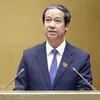For those born outside the territory of Vietnam, the motherland is still kept inside the heart

Many of them are children who having been born outside the territory of Vietnam, are “Vietnamese international citizens”. However, the image of the motherland is still kept inside their hearts and mind, according to the article below, which was sent to Thoi Nay (Present Times) Publication of Nhan Dan (People) Newspaper by author Quyen Gavoye, a Vietnamese expat who is living and working in France.
The children are those who have a father or mother, or both parents, of Vietnamese origin. They may not have the same skin colour or hair colour as Vietnamese, but they all have Vietnamese in their blood. Many of them have never ever been to Vietnam, and there are also many who cannot speak Vietnamese, but they are still proud of their Vietnamese ancestry.
They are still curious about and aware of the Fatherland of their parents and grandparents. That is illustrated through their announcement in front of others that “I am a child of Vietnamese descent” or “My grandparents are people of Vietnamese origin”.
It is not too difficult to catch photos on the internet of blonde-haired and blue-eyed children wearing ‘Ao dai’ (Vietnamese traditional long dress) with the pride in their eyes at their school festivals.
The children may not fully understand the symbolic meaning of the costume, they just put them on because they find it beautiful and want to show off to their friends that this is the traditional Ao Dai of the country where their parents were born.
I have met with many children of Vietnamese ancestry. During a workshop on world’s traditional housing models for primary school students held in the city of Besançon, I had the opportunity to introduce some typical features of a five-section house of Vietnam’s northern region.
After my short presentation, a child, who has blond hair, pinkish white skin, stood up and told me he is Vietnamese. The kid said his grandmother is of Vietnamese origin. Then another one, a boy with big eyes, high nose and typical features of a European, said he is Vietnamese too because his father is Vietnamese.
Once, I passed an old European man. His eyes caught the nametag attached to my jacket, then he asked me whether I am Vietnamese. After that, he spoke to me in a slight Vietnamese accent “Toi cung la nguoi Viet” (I’m Vietnamese, too). He went on to explain further in Vietnamese that he was born and raised in Vietnam.
Education in the Vietnamese family and community abroad makes an important contribution to preserving the national cultural identities outside the border. A typical example is the overseas Vietnamese community in France. To date, there has not yet been an official survey on the number of people of Vietnamese descent living in the French territory. However, according to the figures announced by the Vietnamese Ministry of Foreign Affairs’ State Committee on Overseas Vietnamese in the ‘Que Huong’ (Homeland) journal, around 250,000 to 300,000 Vietnamese are living in France.
French people of Vietnamese origin have exerted effort to preserve and educate Vietnamese culture and language to their descendants. One travelling to District 13 in Paris may have a feeling as if they are visiting Hanoi or Ho Chi Minh City as Vietnamese language is spoken everywhere in the streets. Typical Vietnamese products such as conical hats, Ao dai, mortars and pestles, jars, or natural rice-straw brooms are also available there.
Cultural practices and traditional festivals are well observed by the overseas Vietnamese community in Europe, especially the Lunar New Year (Tet), Vu Lan festival - which is held on the 15th day of the 7th lunar month to express their gratitude toward their parents, and Mid-Autumn Festival.
Joyful celebrations featuring lion dances and fashion shows of Ao Dai are organised for every Lunar New Year festival in big cities such as Berlin, Paris, and London to introduce the Vietnamese national culture to the people in the host countries.
In Paris, the city government hosted many activities on holidays and traditional Tet festival to honour the culture of Vietnam and Asia in general. On the Mid Autumn Festival every year, the Vietnam Youth Association in France coordinates with the Vietnamese Students’ Association in France, the Vietnamese Architects’ Association in France, and the Vietnam Cultural Centre to organise a lantern procession for children of Vietnamese ancestry aged from 3-14 years old at the Montreuil Convention Centre. The event also includes many Vietnamese folk games and performances of French artists.
In the families of Overseas Vietnamese, all family members gather together for a dinner on Lunar New Year’s Eve to enjoy Vietnamese traditional dishes, including ‘chung’ (square glutinous rice cake), ‘thit dong’ (frozen meat stew), ‘gio lua’ (lean pork paste) and boiled chicken. It is an occasion for them to sit together to commemorate ancestors and share stories about national culture to the younger generations.
Tags:





